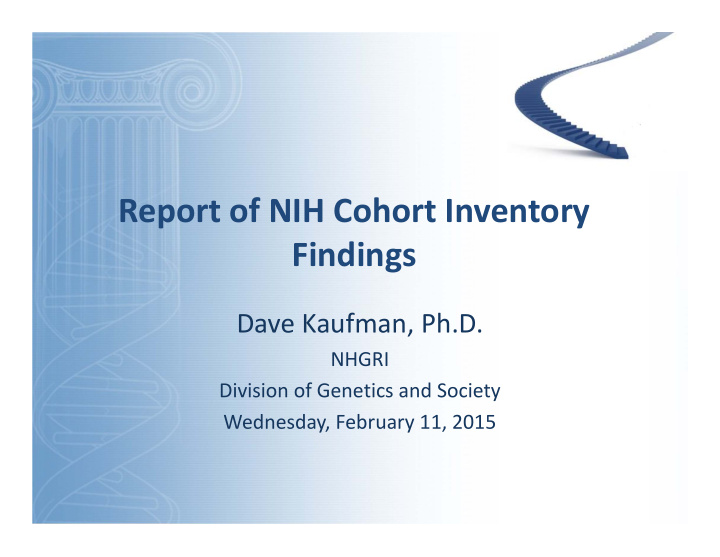



Report of NIH Cohort Inventory Findings Dave Kaufman, Ph.D. NHGRI Division of Genetics and Society Wednesday, February 11, 2015
Cohort inventory
Cohort inventory goal and methods Characteristics for PM cohort • Numbers enrolled • Demography/geography • Consent for broad uses of existing data • Ability to follow up • Biospecimens • Willingness to share data • Linked to EMRs Inventory methods Combined and triaged four cohort lists Among 205 studies and sites • Commonly cited, established • Currently active • Participate in collaborations, consortia • Understudied populations • Internet, PI contacts
Three major types of resources Longitudinal research studies: (53) 5 million people Research oriented healthcare systems (10) 7.3 million people Hospital ‐ based cohort studies (6) 1 million
Overall 69 studies and health systems ~13.3 million people 11 studies <1,000 people 22 studies >100,000 Median 51,000
Funding sources NIH: 6.3 million participants NCI, NHLBI, NIDDK, NIEHS, NIA, NICHD, NIAID, NIMH and others 2.8 million people in longitudinal studies Others: 7 million DoD: 220,000 VA: 330,000 Am. Cancer Society: 2.7 million Health systems: 3.9 million
Geography NIH-funded longitudinal study Other longitudinal study Hospital based cohort Healthcare system
Geography
Current age distributions of 29 epi cohorts 0 20 40 60 80 100
Under ‐ served and under ‐ studied groups African Americans: 317,000+ Latinos: 116,000+ Asian Americans: 90,000+ Native Hawaiians & Pacific Islanders 18,000+ American Indians & Alaska Natives 12,700+ Rural 90,000+
Criteria for incorporation: Active Follow ‐ Up or Ability to Recontact 58 of 69 studies 9.4 m people total 6.7 m from hospital studies & health systems
best case: 2.8m - 6.1m people with samples 32 studies and systems
Value ‐ added characteristics Broad consent 36% have it Genetics 2 in 3 have done some genotyping One quarter have done exome or genome sequencing EMR/Medicare linkage one ‐ third of longitudinal cohorts; half linked to Medicare most/all health systems
Additional potential resources Other studies Other Large Scale Consortia HMO Research Network: 12 million ppts NCI Cohort Consortium: 4 million ppts PCORNet goal: 11 million ppts Independent large scale efforts PatientsLikeMe, 23andMe, Sage Bionetworks, Google+ 1 ‐ 2 million people Biobanks ‐ Henderson GE and Cadigan RJ, UNC 120+ w/ broad consent, ability to recontact 1.6 million people
From Cohort PIs: • Enthusiasm for PM Cohort • Re ‐ consent is possible but impractical • Already experienced harmonizing • Engagement will be needed
Thanks to: Rebecca Baker Allison Lea Stephanie Devaney Teri Manolio Joanne Elena Scott Rogers Study PIs
Recommend
More recommend